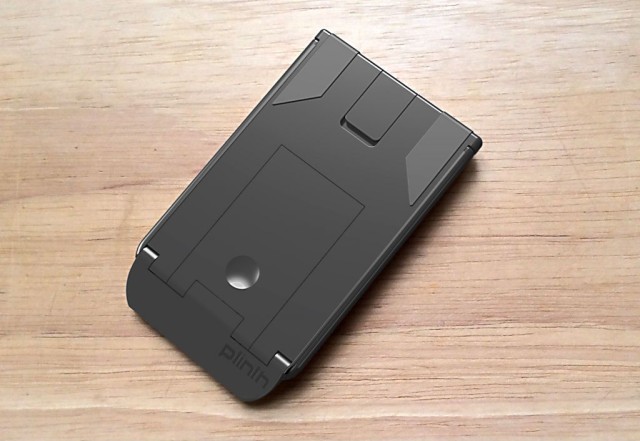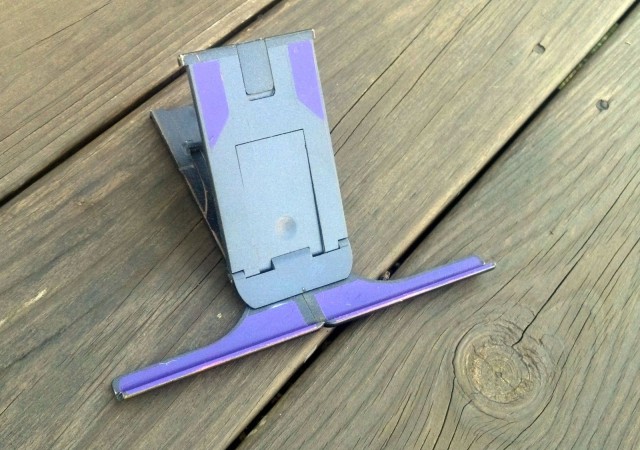The Perplexing Plinth Is The Only Tablet Stand You’ll Ever Need [Hands On]
The Plinth isn’t just a super-compact tablet stand — it’s an amusing party trick.
Slide the sleek accessory out of your pocket or purse and into the hands of a friend and you’ll likely be met with a quizzical stare as they try to figure out what, exactly, the flat plastic object is. Thin, feather-light and somewhat curiously shaped, the Plinth — which currently exists only as a 3-D prototype, although if you’re quick you can get in on the Kickstarter campaign — looks something like a Chinese puzzle box or a Transformer in stealth mode.
It’s obviously composed of multiple parts that fit together seamlessly, and a couple of buttons look like they might do something. But let a friend fondle the plastic object, and they’ll likely fiddle with it for a while before they discover the Plinth’s awesome secret.
“That’s so cool!” said my test subject when she finally figured out how to manipulate the Plinth’s sliding latch, which instantly unleashes the tablet holder’s spring-loaded arms. It’s not that the Plinth is difficult to deploy. In fact, once you figure out the Plinth’s trick, it’s incredibly simple (and switchblade-fast) to open.
English product designer John Bull invented the Plinth, and to some degree his story unfolds like a classic “build a better mousetrap” scenario. He’s already done the hard part — designing a unique product that fills a certain need — but he’s encountered a distinctly modern difficulty as he seeks to get the world to beat a path to his door. Kickstarter might make it possible for inventors to take their creations public, but it doesn’t necessarily make it simple, especially for an inventor facing a large tooling bill for a low-priced product.
“I’m quite confident with the design side of it,” Bull told Cult of Android as he discussed his work on the Plinth. “I’m not very good at the marketing.”
This being his first go at Kickstarter, Bull learned by trial and error and even took the unusual step of pulling the Plinth from the crowd-funding site while he revamped the campaign. With some tips from CrowdCrux, a dedicated Plinth website and a revised Kickstarter listing, Bull is now three-quarters of the way to achieving his goal for getting the stealthy folding stand into production.
And thank goodness for that, because the Plinth is a wonderful creation that makes any tablet (or a phablet or standard smartphone, for that matter) even more useful and enjoyable. The Plinth adjusts to five different angles, making it simple to look at your tablet hands-free and also takes much of the sting out of typing on a slate’s virtual keyboard.
Bull says he designed the Plinth because he loved his iPad but despised Apple’s Smart Cover. He didn’t want to put a case on his trusty tablet but he needed a stand that would make it easier to type. The stand had to be small and light enough that he could easily carry it and use it anywhere, and he didn’t want to wrestle with a cumbersome stand he had to unfold every time he wanted to set it up.
“That, to me, is quite precious,” said Bull, who tried out many other stands before finalizing the Plinth’s design.
Bull loaned Cult of Android a prototype Plinth, and after using it, we can confirm that the stand works as advertised. At about the size of an iPhone, it’s light (50 grams), easy to stow and measures a svelte 10 millimeters thick. It holds tablets, phones or even books, if they are slender enough to fit the Plinth’s arms. (The prototype only adjusted to three angles, but Bull has upgraded the design to provide more flexibility.)
Bull said he was mindful of women as he designed the gadget stand, making sure it was as discreet and unobtrusive as possible, and ensuring it would fit safely inside a tiny purse or slip into lightweight clothing during hot weather.
As for the final product, Bull promises that “it’ll be drop-dead sexy.” The Plinth’s injection-molded plastic surfaces will be augmented with grippy rubber pads, strategically placed to hold even a large tablet safely in place.
The trigger button that deploys the Plinth’s arms can’t be accidentally released in a purse or pants pocket. “All surfaces will match up absolutely perfectly,” Bull said.
The mix of materials will create a durable product that provides a pleasingly tactile experience similar to a camera or a high-end toothbrush, according to the designer, who’s previously developed industrial safety equipment, nursery products and a rucksack with a harness system. “I’ve worked on some quite revolutionary stuff over the years, but it’s all been quite niche,” he said.
When asked whether he thought his decision to make the Plinth of injection-molded plastic over something slicker — like, say, the iPad’s aluminum case — he said he let common sense be his guide.
“Plastic is the right material,” Bull said, because creating the Plinth’s thin walls out of aluminum would likely lead to a product that cracked or even shattered.
The plastic, on the other hand, will be almost invincible. “You can jump up and down on it and it would probably just grin at you,” Bull said.
The English inventor has quite a lot riding on the Plinth. He’s worked for more than a year perfecting his design and hasn’t made a penny so far. He’s spent many hours refining his Kickstarter pitch, and he needs lots of backers to cover the upfront tooling costs for the relatively inexpensive product (you can preorder one for approximately $30, international shipping included, and get an even better deal if you order multiple units). He’s also painfully aware that if the wrong people spot his design, a copycat product might pop up in the Chinese marketplace.
Still, he remains optimistic — perhaps because he knows, deep down, that he’s built the fabled “better mousetrap.”
“I very much want to make this product happen,” Bull said. “It will be quite a sexy thing.”
- SourceKickstarter




